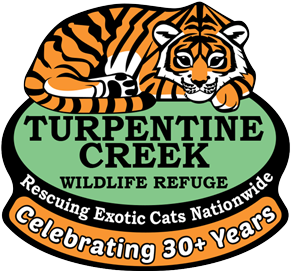Animal Cruelty Awareness Week
April 20, 2020
It is Animal Cruelty Awareness Week and Turpentine Creek wants to raise awareness about the life of exotic felines being held in backyards and roadside zoos.
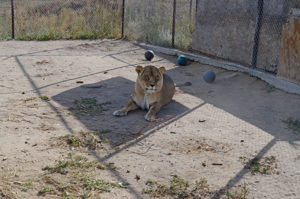 Roadside zoos exist all over the country with one motive: money. Many are found along busy roads, meant to be a quick stop for tourists. But, they can also be drive-through safaris, traveling zoos, and petting zoos. They usually give an interactive experience, luring people in with the options to feed animals or engage in hands-on interaction. Sometimes, roadside zoos are disguised as “sanctuaries” or “rescues”. These titles create the illusion that these facilities are rescues, and that by partaking in their activities, you are helping the animals. Animals in these facilities are not rescues but bought from notorious breeders or bred by the facilities themselves.
Roadside zoos exist all over the country with one motive: money. Many are found along busy roads, meant to be a quick stop for tourists. But, they can also be drive-through safaris, traveling zoos, and petting zoos. They usually give an interactive experience, luring people in with the options to feed animals or engage in hands-on interaction. Sometimes, roadside zoos are disguised as “sanctuaries” or “rescues”. These titles create the illusion that these facilities are rescues, and that by partaking in their activities, you are helping the animals. Animals in these facilities are not rescues but bought from notorious breeders or bred by the facilities themselves.
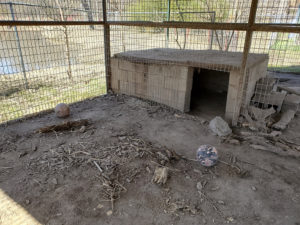 Roadside zoos often employ people with no education or expertise in the care of animals. Because of the lack of knowledge, the living conditions for the animals tend to be horrifying. To conserve money and space, animal enclosures may be built with no thought of the needs of the species. Oftentimes, animals have no escape from the weather. In some cases, the enclosures are not big enough for them to move or even stand to their full height. Some enclosures may experience crowding, causing stress if not managed properly. Enclosures may not be cleaned on a regular schedule, leading to an excess of feces and rotting food. This becomes a breeding ground for insects and bacteria that spread disease.
Roadside zoos often employ people with no education or expertise in the care of animals. Because of the lack of knowledge, the living conditions for the animals tend to be horrifying. To conserve money and space, animal enclosures may be built with no thought of the needs of the species. Oftentimes, animals have no escape from the weather. In some cases, the enclosures are not big enough for them to move or even stand to their full height. Some enclosures may experience crowding, causing stress if not managed properly. Enclosures may not be cleaned on a regular schedule, leading to an excess of feces and rotting food. This becomes a breeding ground for insects and bacteria that spread disease.
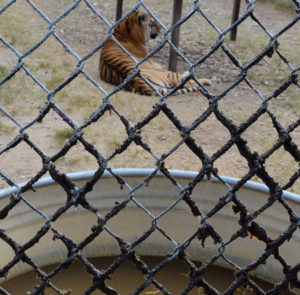 Exotic felines have very particular, and expensive, dietary and nutritional needs. Because of the large price tag associated with a proper diet, animals in pseudo-facilities are oftentimes malnourished, developing health issues. They may be overfed, underfed, or not fed on a regular basis at all. If an animal does become ill, there is typically a high mortality rate due to many symptoms of illnesses or diseases not being recognized or being treated improperly. Proper medical care is typically nonexistent due to the lack of knowledge and steep price of veterinary care and medicines. These questionable tactics lead to sick animals suffering for a long period of time before they receive treatment, or even pass away.
Exotic felines have very particular, and expensive, dietary and nutritional needs. Because of the large price tag associated with a proper diet, animals in pseudo-facilities are oftentimes malnourished, developing health issues. They may be overfed, underfed, or not fed on a regular basis at all. If an animal does become ill, there is typically a high mortality rate due to many symptoms of illnesses or diseases not being recognized or being treated improperly. Proper medical care is typically nonexistent due to the lack of knowledge and steep price of veterinary care and medicines. These questionable tactics lead to sick animals suffering for a long period of time before they receive treatment, or even pass away.
There may be zoos that provide clean enclosures and adequate food, but do not meet the complex requirements for wild animals in captivity. There are a number of needs that need to be met from exercise to privacy. Any facility that keeps wild animals for the purpose of human entertainment and amusement is not helping the animal, but merely exploiting them. Roadside zoos are not accredited by the Association of Zoos and Aquariums (AZA). In the United States alone, less than 10% of animal exhibitors licensed by the United States Department of Agriculture (USDA) are accredited by AZA.
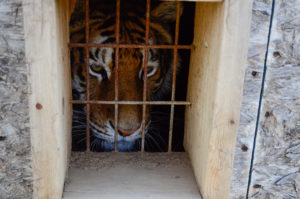 Since there are so many of these roadside zoos, how does one differentiate a true facility from a roadside zoo? Sanctuaries are strictly that, a sanctuary, or place of refuge for animals who have been abused or neglected. AZA zoos have a breeding program in place called Species Survival Plans. These plans aid in conservation of animals whose populations are extremely low in the wild. We understand that it can be difficult to know the difference on your own, so Turpentine Creek Wildlife Refuge has created a True Sanctuary Checklist to help you out! One of the most important things to know is that no true sanctuary will buy, sell, breed, sell or offer hands-on interaction with their animals. By using the questions on the True Sanctuary Checklist as guidelines, it makes learning about facilities and their true motives more straightforward. Researching before you go to any animal facility can make the biggest difference for these animals.
Since there are so many of these roadside zoos, how does one differentiate a true facility from a roadside zoo? Sanctuaries are strictly that, a sanctuary, or place of refuge for animals who have been abused or neglected. AZA zoos have a breeding program in place called Species Survival Plans. These plans aid in conservation of animals whose populations are extremely low in the wild. We understand that it can be difficult to know the difference on your own, so Turpentine Creek Wildlife Refuge has created a True Sanctuary Checklist to help you out! One of the most important things to know is that no true sanctuary will buy, sell, breed, sell or offer hands-on interaction with their animals. By using the questions on the True Sanctuary Checklist as guidelines, it makes learning about facilities and their true motives more straightforward. Researching before you go to any animal facility can make the biggest difference for these animals.
